Spencer Tunick’s photographs have brought him great renown, but his work was and continues to be hazardous, exposing the unstable rules about art and nudity in public space
‘It’s very wonderful, my medium has feet,’ says American photographer Spencer Tunick. Many feet, in fact. Masses of naked bodies populate his works, standing up, lying down, painted blue, lifted up, holding hands, in public spaces all over the world – from New York, to Bogotá and Jerusalem. The men and women who feature in his photographs are usually volunteers from the city or town where Tunick has organised a shoot. Nudity can make them look more powerful, but often shows them at their most vulnerable and exposed. But the most endangered body in these photoshoots is Spencer Tunick’s own.
Tunick’s work has always drawn the attention of the authorities, and where that attention is negative, he bears the brunt of it. ‘Logistically it’s much easier to arrest the instigator of the action because I’m just one person,’ he explains. ‘To arrest 500 people you would need at least 1,000 police officers.’ Not one of the thousands of undressed people he has photographed over the years has ever gotten into trouble as a result – even when, at one of his shoots, ‘police officers almost outnumbered the participants.’ The only exceptions are Tunick’s wife Kristin Bowler and one other model, who were arrested during a two-person photoshoot in New York in 1996 – and they were only given a ticket.
Tunick is not interested in sexualised imagery: the boundaries he wants to push against are political. ‘I use the bodies as a tool against repressive governments and against repressive people, and I also use it, in a way, for beauty, so that we have an explosion of life. I am working with two different mindsets. My work is trying to think about the juxtaposition of the body and its vulnerability, but also its power, and to change the meaning of the background, the environment.’ But whatever his intentions, the threat of being prosecuted for indecency looms large.
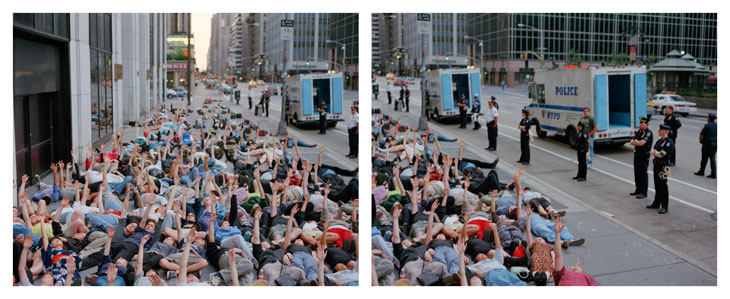
Sex Drive, NYC (diptych; 1999), Spencer Tunick. Courtesy of the artist
When he started out in the early 1990s, Tunick enjoyed the ‘romantic idea’ of doing something that could land him in trouble. But this changed after being arrested five times between 1995 and 1999. ‘Being handcuffed is very painful’, he recalls. ‘To get stuffed in the police car, it’s very traumatic, I was in a lot of pain after getting out. And then they put you in The Tombs.’ In the Manhattan Detention Complex (as it’s officially known), Tunick had to share a room with about 30 other people, with just one toilet concealed by a small wall in the centre of the room. ‘It’s humiliating and it’s a very dangerous situation. You are in there with anyone: they could have committed a horrific crime or jumped the subway turnstile.’
Facing the risk of the legal limbo of hours in jail (they would sometimes keep him for almost 24 hours), as well as the loss of his photographs, he began to take precautions for every group work he organised, writing down his lawyer’s phone number on his arm with a Sharpie and having an assistant with him ready to hide his filmrolls.
Tunick also came up with some surreal distractions to shield his work from police involvement: ‘I once had a person dress up as a mythical magician, with a pointy hat and a magician suit, and when the police came by, we’d pretend to be photographing him.’ Slapstick ensued as the actual, naked subjects of his shoot would hide under the magician’s cape, behind a wall or on the other side of the street. Tunick’s decoy tactics give a whole new meaning to ‘hiding in plain sight’. ‘Once, I had somebody dressed up in a grape suit; like, a giant grape. Another time, as I was on the Brooklyn Bridge and police would come by when people were gathering, we had a sign that said Birdwatching Tour.’
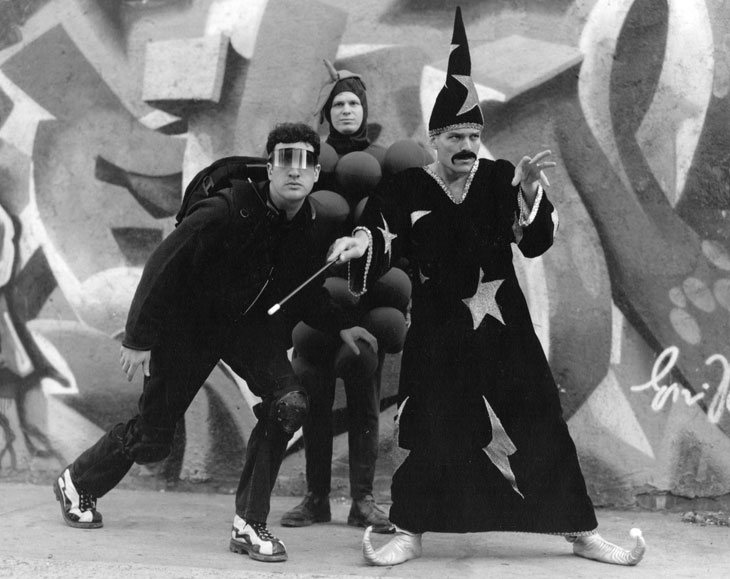
Decoys (1994). Tunick’s crew (Chris Trela, in the grape suit, and Justin Jay, in the magician suit) pose in their decoy attire. Spencer Tunick (left) is not dressed up (aside from the visors) but wears his usual photoshoot apparel, including kneepads, to protect him during long periods kneeling to take pictures. Courtesy of the artist
Still, after five arrests (all charges were eventually dropped), Tunick grew weary of his precarious position and the physical and legal risks it entailed. In 1999 he decided to pursue the official route, which paradoxically confused matters further.
The first tactic he used was to apply for a permit for a photoshoot – without mentioning the nudity. Then he would reapply, citing exactly the same project, only with undressed subject. This way, he could ensure that ‘they couldn’t make up any issues about [us] stopping traffic.’ Since there was no blanket ban for nudity in New York City, he was optimistic that this would work. But when people gathered for Tunick’s project Sex Drive in 1999, police cars were already waiting at the scene, and officers warned that everyone would get arrested if anyone took off their clothes. The only photos of Sex Drive record the menacing sight of fully dressed people lying on the pavement, flanked by police vans and officers with folded arms.
So Tunick decided to go through the courts, fighting to obtain a permit for a new piece, Good Citizens, by arguing his right to artistic nudity. Lawyers of the City of New York pushed the case all the way to the Supreme Court through a series of appeals, but to no avail. In 2000, Tunick was granted his request to shoot the work in 15 minutes, just before sunrise, under the Williamsburg Bridge. Although this was a landmark victory, it did not make things easier for Tunick in the long run. ‘Even though I’d won, I’d just won that one location. I could still be arrested! I then applied for another permit, but the city turned it down. Basically, the city was saying: “we don’t care if you’ve won, we won’t give you a permit and we’ll arrest you and the participants.” So even if you win, you lose.’
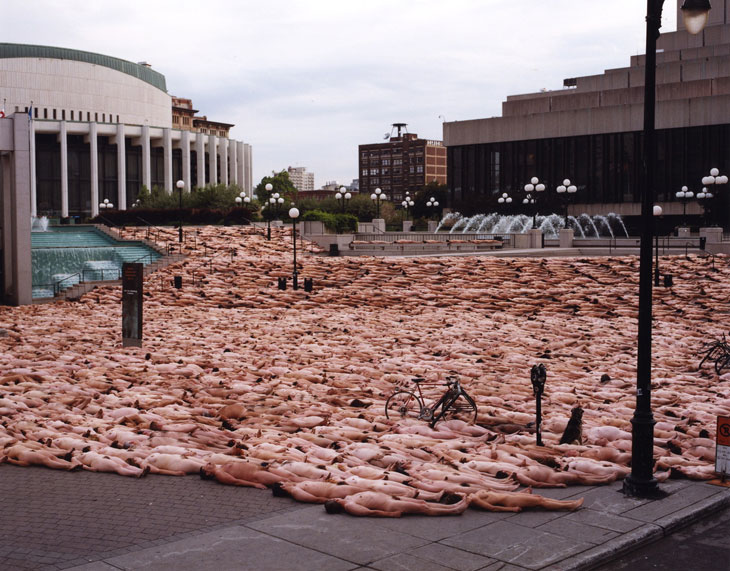
Montreal 3 (Musée d’Art Contemporain de Montréal; 2001), Spencer Tunick. Courtesy of the artist
Tunick has not photographed outdoors in New York City for 16 years. However, as with many artists who push the boundaries, the resistance he encountered ultimately helped his career. A few months later ‘I was sort of rescued when I was commissioned by the Museum of Contemporary Art in Montréal. The city invited me and they said “work wherever you want – and how can we help you?”’ The contrast with his experiences in New York could not have been greater. ‘It was like the mayor up North was sending this giant middle finger up to Giuliani. You know: “You might repress artists in New York, but here in Montréal, not only are we not going to arrest him, we are going to celebrate him and the people posing for him.”’
The Montréal invitation was fundamental for Tunick. Not only did it ‘bring the dignity back’ to his work, but with the city’s support he was also able to spend much more time on his photos, dramatically changing the results. Previously, in New York, Tunick estimates that he had ‘three minutes, eight minutes’ to complete a project. ‘I definitely had to shout a lot. The people in the front thought I was going crazy and the people in the back couldn’t hear me.’ But in Montréal, working conditions were very different. ‘I started to be able to relax, and my work started to change. Early on it was more like a Jackson Pollock painting, more of an action piece, where the bodies were just splattered and abstract… And I loved those types of works, and sometimes I revisit them. But then the work started to change.’ The bodies in Tunick’s more recent photographs are intricately arranged, choreographed even. Some hold props, others are viewed from unexpected angles, such as the bird’s-eye shot of blue bodies flowing around the Rosebowl fountain in Sea of Hull (2016).
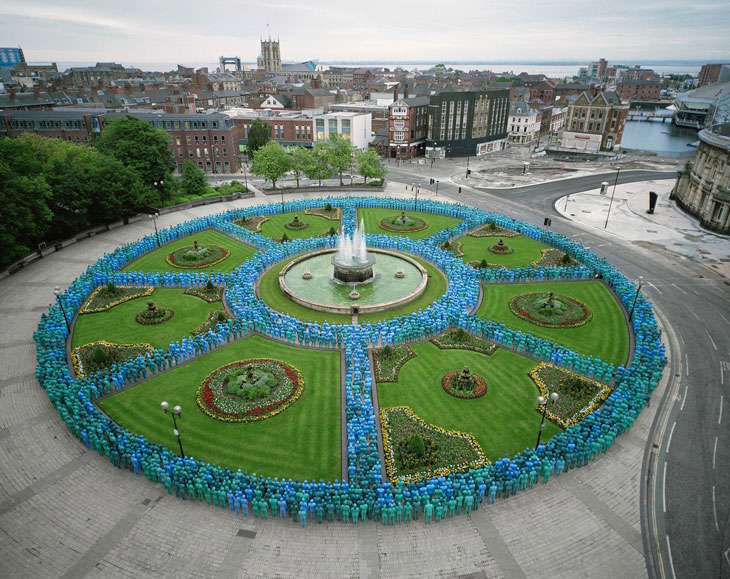
Sea of Hull (Rosebowl, Hull; 2016), Spencer Tunick. Courtesy of the artist
The success of Montréal did not signal smooth sailing from that moment on. The political response to his projects oscillates wildly around the world, mirroring the duality of violence and beauty in the photographs themselves.
In 2002 in Chile, opponents took Tunick all the way to the Supreme Court in an unsuccesful attempt to halt his plans for a project there. He remembers that shortly before the photography began there were around 200 protestors outside his hotel, ‘shouting the usual stuff, Sodom, Gomorra, etc. But after the photoshoot involving some 5,000 people, the Chilean president said that, if he had been young, he would have taken part himself. I was named Man of the Year by a national newspaper.’
In 2007 ‘I was doing a work in Mexico City. Forty-thousand people signed up, and at the last minute – three or four days before the event – the president of the country said I didn’t have permission to use the Zócalo [the city’s main square].’ Tunick refused to cancel the event. His gamble paid off. ‘Someone had the ear of the president’, he explains, ‘and two days before the installation happened, we got the word from the president’s office that we would be allowed to do the work. Over 20,000 came: 18,000 people were let in, 2,000 had to be left out. There were just too many. It was just a great moment. No one would have thought that, of all the places in the world, Mexico City would have the most open-minded people when it came to their bodies.’
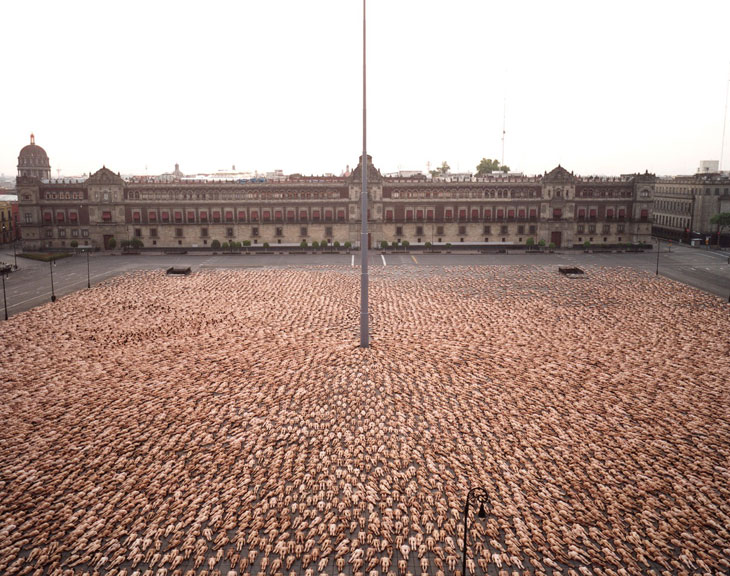
Mexico City 3 (Zócalo, MUCA/UNAM; 2007), Spencer Tunick. Courtesy of the artist
Has Tunick become more careful over the years? ‘If someone were to say to me, “come to Turkey and you’ll make some work, we’ll keep you protected,” I might not take that risk, and leave the spot for some other young artist who doesn’t have two young kids.’ On the other hand, his interest in making political statements endures. A recent project saw people joining hands to form a ‘bridge’ in a statement against Brexit (2016’s Humber Bridge 1 (Barton Foreshore)). Next on his wish list is a return to New York. ‘With all this rhetoric by Donald Trump, I just want to create an explosion of people in Times Square. I just want to say: “This is life and this is not moving. This is what it is, this is what you’re going to get.”’ He also plans to go to Washington D.C. to push the legal boundaries of what is already a fairly liberal place. ‘Women can be topless, which is wonderful, but it’s dealing with the bottom half of the body that is the problem. So I was thinking, why not just fight it in the court system and bring some dignity to the body?’ If he’s successful there, he hopes that ‘maybe it will set the tone for other places.’
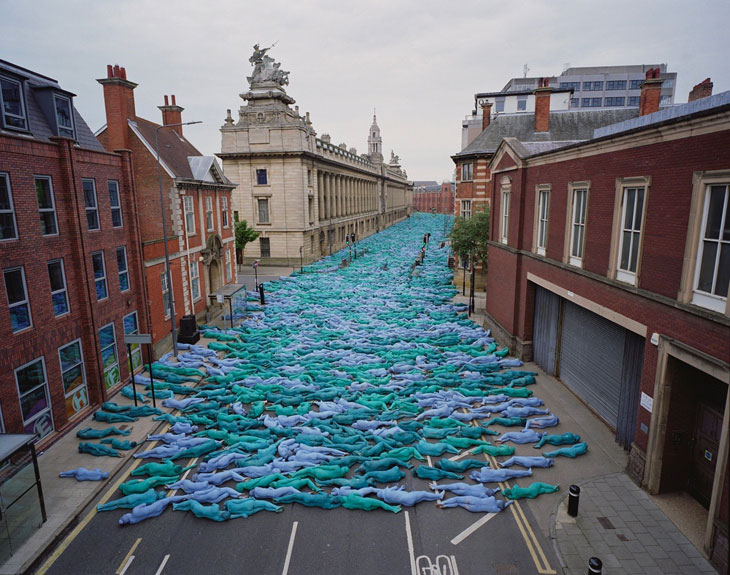
Sea of Hull (Alfred Gelder Street, Hull; 2016), Spencer Tunick. Courtesy of the artist
Unsurprisingly, Tunick is not a fan of fashion – or clothes, for that matter. ‘People are more present when they’re undressed’ he explains. ‘It’s definitely a lot easier for me to talk to 150 naked people, than 150 clothed people.’ But on occasion clothes do come in handy. If his D.C. project does not get legal backing, Tunick wants to do it anyway, with a couple of volunteers who will impersonate him. He smiles broadly. ‘And you know, we will all dress the same and then… sneak away.’
Spencer Tunick’s work features in the Socle du Monde Biennale in Herning, Denmark, until 27 August, and in the exhibition ‘Skin: Freud, Mueck and Tunick’ at Ferens Art Gallery, Hull, until 13 August.
Reaction Zone, the artist’s limited edition book of New York projects, was published this year.
Unlimited access from just $16 every 3 months
Subscribe to get unlimited and exclusive access to the top art stories, interviews and exhibition reviews.

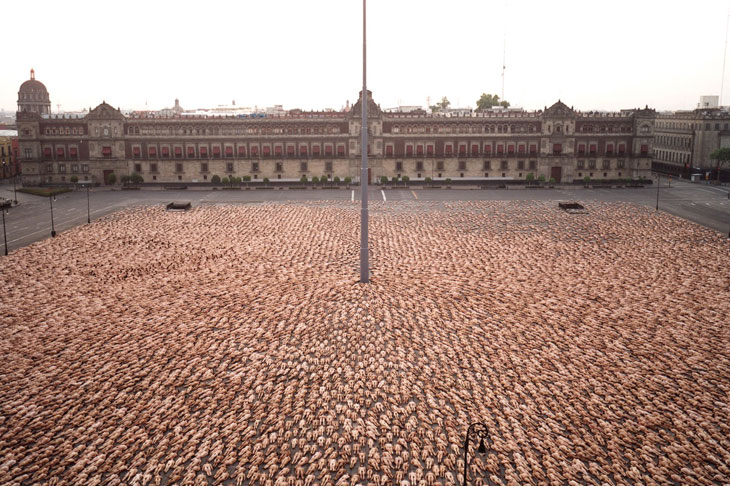

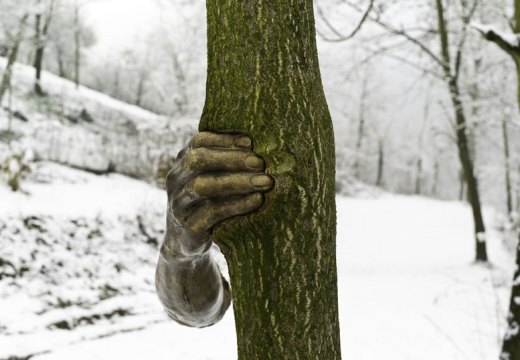
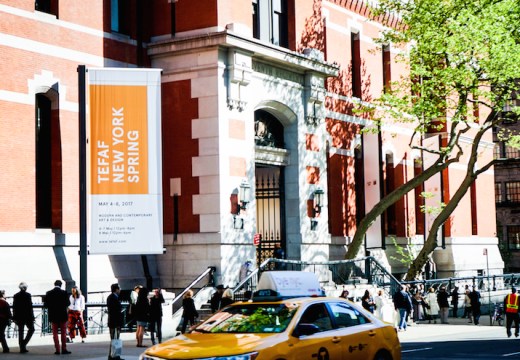









![Masterpiece [Re]discovery 2022. Photo: Ben Fisher Photography, courtesy of Masterpiece London](http://www.apollo-magazine.com/wp-content/uploads/2022/07/MPL2022_4263.jpg)
Why are fathers so absent from art history?